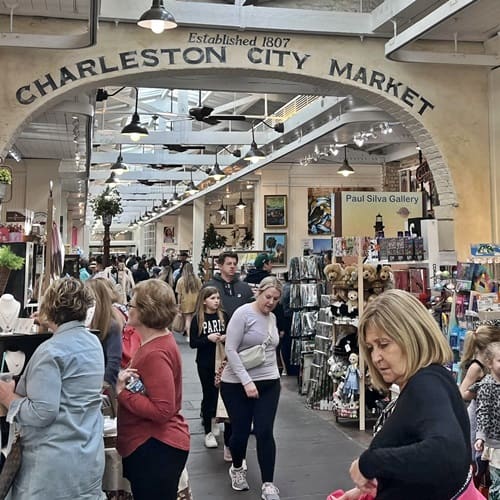
Charleston TourPass
View Signature Tour availability prior to purchasing a pass
(Does not show times for Classic Attractions that you can visit anytime during their operating hours)
The City Market is a famous Charleston landmark and a favorite of visitors. Encompassing four city blocks from Meeting to East Bay Streets, the City Market houses is known for Sweetgrass baskets, tremendous restaurants, bars, local vendors selling everything from jewelery to novelty items and is where the immensely popular carriage tours depart from.
Market Hall Painstakingly restored, this Roman Revival building soars as majestically above Charleston’s tourism trade as it once did over the beef market that occupied the block behind it. While most of the building is brick covered with rouge-tinted stucco (colored in some areas with pigmented lime wash), it also has brownstone details and bronze ornaments in the frieze depicting the skulls of rams and oxen, the use of which to indicate proximity to a meat market has precedence in Roman architecture.
During the Civil War, the upper floor was used as a venue for balls to support the Confederate cause and is today leased by the Daughters of the Confederacy where a museum is housed. The legendary Palmetto Guard was honored here before going to war, and the veterans gathered here annually to remember their fallen comrades through 1917, when the last two survivors met.
City Market Where the City Market now stands was originally a tidal creek that ran just north of the walled Colonial city of Charles Towne. The creek was filled in and the land donated to the city for the placement of an open-air food market, a purpose the present buildings served from 1804 until the early 20th century. Victorian era photographs show basket-toting women in the streets at the Beef Market, dodging turkey buzzards (euphemistically referred to in contemporary accounts as “Charleston eagles”), which kept the area clean.
Among the vendors who now occupy the Market are ladies demonstrating the originally African craft of sweetgrass basketry, the most visible vestige of Gullah culture. The word “Gullah” likely originated from the word “Angola”, which in the early 18th-century referred to the region generally south of the Congo River from which most slaves were brought. By mid-century, Planters were showing a distinct preference for Slaves from the coastal areas above the Congo, where rice was a major crop and methods from those areas were being employed in the Lowcountry rice industry. Baskets like these were used for winnowing – tossing the pounded grains through the air to let the breeze carry away the chaff – and virtually identical baskets found in Senegal Africa were used there for the same purpose.
See map below for address

Pass purchases can be refunded (minus 3% credit card processing fees) if requested within thirty-days of purchase date (for unused passes). Optional Trip Insurance can be purchased for a nominal fee at checkout which extends the refund period up to one-year from purchase date. Conditions apply. View full refund policy by clicking button below.